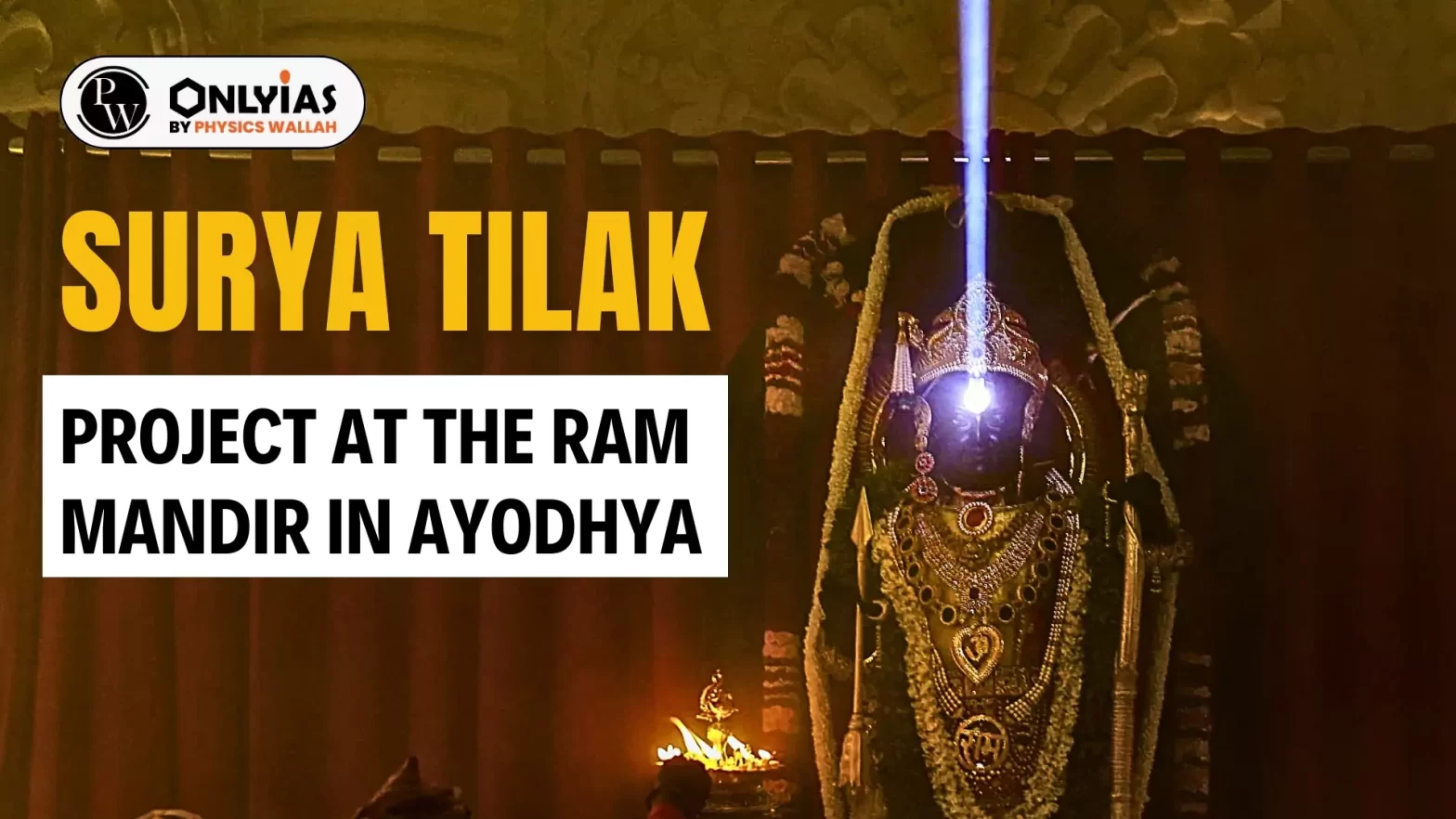Context
Last month, a sunbeam reignited a debate on the role of science and religion in Indian society.
| Relevance For Prelims: Indian Institute of Astrophysics (IIA), Department of Science and Technology (DST), Central Building Research Institute (CBRI), Council of Scientific and Industrial Research (CSIR), SATYAM (Science and Technology of Yoga and Meditation).
Relevance For Mains: Role of science and religion in Indian society. |
About Surya Tilak Project (Sunbeam)
- IIA Contribution to ‘Surya Tilak Project’: Department of Science and Technology (DST) announced that the Indian Institute of Astrophysics (IIA) had significantly contributed to the ‘surya tilak project at the Ram Mandir in Ayodhya.
- Surya Tilak project: The ‘surya tilak project’ involved directing a beam of sunlight precisely onto Ram Lalla’s forehead.
- The IIA, known for designing mirrors and lenses for capturing light from celestial bodies, contributed by designing a system to manipulate light to achieve this effect.
Enroll now for UPSC Online Course
Primary Objections Regarding the Surya Tilak Project
- Astrophysicists’ Involvement: Certain scientists’ contention was that the system could have been designed by a college-level student, thus questioning the necessity of engaging India’s top astrophysicists and astronomers.
- Constitutional Concerns: A major objection was raised regarding the participation of the IIA, an autonomous body under the Department of Science and Technology (DST), in a religious event, which was seen as conflicting with the Constitution’s emphasis on ‘scientific temper.’
- Specific Concerns regarding IIA: The Central Building Research Institute (CBRI) was responsible for setting up the ‘surya tilak’ system, yet no objections were raised regarding its involvement.
- This suggests that either the CBRI’s expertise isn’t considered ‘scientific,‘ or the concern lies in the association of astronomers and astrophysicists with a religious event.
Historical Context of Scientific Temper in India
- Origins of Scientific Temper in India: The concept of scientific temper, although coined during the Nehruvian era, finds its roots in the reformist ideologies championed by figures such as Raja Ram Mohan Roy and P.C. Ray.
- Later, in post-independence India, scientists and technology leaders like Satish Dhawan, Abdur Rahman, and P.M. Bhargava, who helmed some of the country’s foremost scientific institutions, further propagated and advanced this notion.
- Scientific Rationality and Religious Intersection: From the era of Ram Mohan Roy to the contemporary times, this principle underscores a broader dedication to rational inquiry and evidence-driven reasoning.
- It notably emerges in Indian public discourse, especially when scientific methodologies intersect with religious rituals and beliefs.
- Challenges to Scientific Temper in Recent Decades: Over the past twenty years, discussions on scientific temper have been provoked by initiatives to incorporate Vedic astrology into college curricula and claims suggesting that ancient Indians possessed aviation technology.
- Efforts to Modernize Local Calendars: The most salient example of this was an attempt by a scientific committee constituted by Jawaharlal Nehru and led by the eminent astrophysicist Meghnad Saha, to put India’s 30-odd local calendars (panchangas) on a more scientific footing.
- Analysis by the Calendar Reform Committee: The committee, known as the Calendar Reform Committee, conducted an extensive examination not only of the timekeeping mechanisms within Indian calendars but also delved deeply into the historical evolution of calendars across various civilizations.
- Creation of the Indian National Calendar: The committee’s 1956 report resulted in the establishment of the Indian National Calendar, which rectified anomalies through the addition of leap years, standardization of month lengths to 30 or 31 days, and the establishment of Indian Standard Time.
- Limited Adoption of Calendar Reforms: Despite being enforced by an Act of Parliament, only the last of these has been adopted into everyday life.
- Lack of Widespread Adoption: Today, except for government gazettes, there is no trace of this Gregorian-scale innovation, and a plethora of religious and secular ‘new years’ still proliferate.
- Retaining Cultural Significance in Timekeeping: The Calendar, while attempting to correct tradition, took pains to retain Indianness. As per this Calendar, the present is Vaisakha 1946. The makers specified that it would be useful for astrologers to calculate religious festivals.
Diverse Approaches in Indian Scientific Endeavors
- DST’s Sole Reliance on PAC: If the DST had exclusively relied on the Positional Astronomy Centre (PAC), a division of the India Meteorological Department established following the Calendar committee report, it would not have required the involvement of the IIA.
- PAC’s Annual Publication for Astronomical Guidance: The Positional Astronomy Centre (PAC) issues a yearly document containing details of public holidays, a plethora of festivals, positions of celestial bodies such as the sun, moon, and key planets, aiding both astronomers and astrologers alike.
- DST’s Support for Diverse Scientific Studies: In addition to backing conventional scientific fields, the DST has funded projects like SATYAM (Science and Technology of Yoga and Meditation), which, despite extensive research, has not uncovered new insights into yoga and meditation.
- Exploring Medicinal Potential of Cow-Derived Substances: Another initiative, the Scientific Validation and Research on Panchgavya, led by the Indian Institute of Technology Delhi, explores the medicinal properties of cow-derived substances.
Enroll now for UPSC Online Classes
Conclusion
This approach mirrors Indian secularism’s inclusivity of diverse religious practices, contrasting with the European model of church-state separation. Indian science, when confronted with religious contexts, tends to exhibit a balanced stance.
Also Read: India’s R&D Funding Landscape

